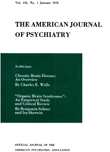THE ANTICIPATION AND PREVENTION OF CARDIAC COMPLICATIONS IN ELECTROCONVULSIVE THERAPY
Abstract
In order to overcome the multiple insults to cardio-respiratory equilibrium incident to the convulsion, therapeutic measures should be directed to early oxygenation of the alveoli and the maintenance of central and peripheral circulator mechanisms to deliver oxygenated blood to the myocardial, cerebral, and other tissues. Since circulatory function and respiration are interdependent, changes in one function are rapidly reflected in the other, and failure of one inevitably leads to failure of the other. Therapeutic measures to support the failing circulation are best done, before the critical postconvulsive state exists, in the form of atropinization to prevent vagal effects and other supportive measures, such as administration of digitalis, quinidine, aminophylline, and other medications before treatment is begun(7, 16). Respiratory failure is more easily dealt with at the time of occurrence, and the early institution of oxygen inhalations with the aid of artificial respiration and mechanical air way is far more beneficial than heroic measures later.
Utilizing these principles, patients with serious cardiac disease can be safely and confidently given the benefits of electroshock therapy. Four patients having suffered acute coronary thrombosis prior to treatment have been successfully treated, and 3 patients having suffered episodes of congestive failure and taking digitalis during the course of treatment were treated uneventfully.
Access content
To read the fulltext, please use one of the options below to sign in or purchase access.- Personal login
- Institutional Login
- Sign in via OpenAthens
- Register for access
-
Please login/register if you wish to pair your device and check access availability.
Not a subscriber?
PsychiatryOnline subscription options offer access to the DSM-5 library, books, journals, CME, and patient resources. This all-in-one virtual library provides psychiatrists and mental health professionals with key resources for diagnosis, treatment, research, and professional development.
Need more help? PsychiatryOnline Customer Service may be reached by emailing [email protected] or by calling 800-368-5777 (in the U.S.) or 703-907-7322 (outside the U.S.).



